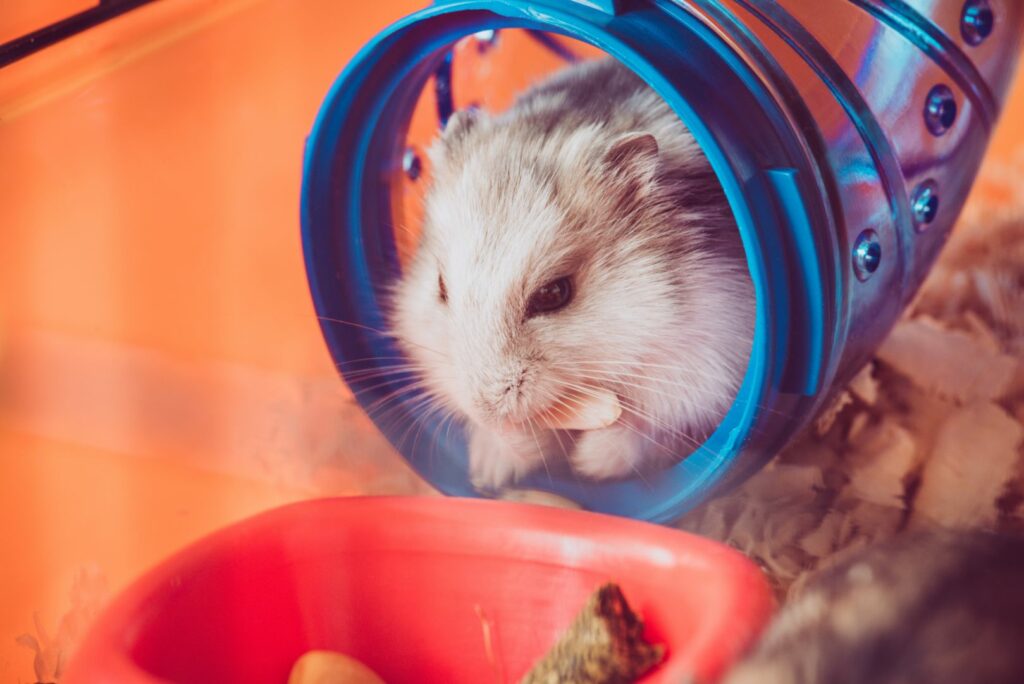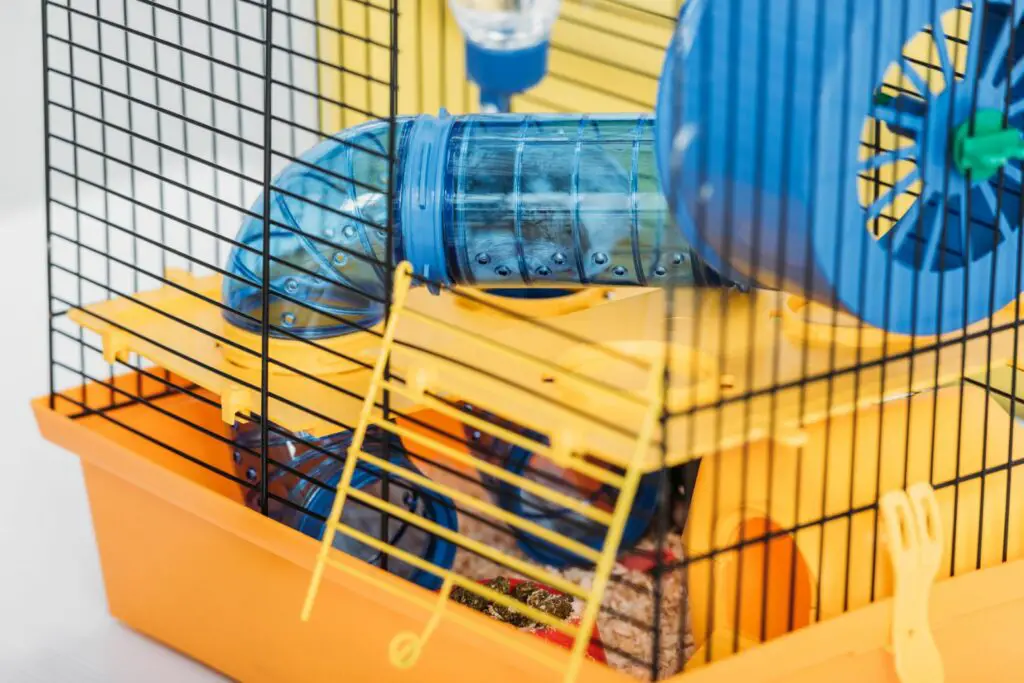As a veterinarian, I’ve encountered many hamster owners who are interested in adding hamster tubes to their pet’s habitat. Hamster tubes are a popular addition to many hamster habitats, but it’s important to ensure that they are safe and suitable for your pet.
In this guide, we’ll cover everything you need to know about hamster tubes, including whether or not hamsters like them, the different types available, and how to ensure they are safe for your furry friend.

Do Hamsters Like Hamster Tubes?
Hamsters are known for their love of exploring and burrowing, making hamster tubes an enticing addition to their habitat.
Not only do hamster tubes provide a fun and stimulating environment for hamsters to explore, but they can also help to prevent boredom and promote exercise.
However, it’s important to note that not all hamsters may enjoy hamster tubes. Some may be timid or anxious and may be hesitant to venture into the tubes. It’s important to observe your hamster’s behavior and adjust the habitat accordingly.
Benefits of Hamster Tubes
Aside from providing a fun and stimulating environment for hamsters, hamster tubes also have several other benefits. For example, they can help to prevent boredom and reduce stress in hamsters. They can also promote exercise and help to prevent obesity, which is a common problem in hamsters who don’t get enough activity. Additionally, hamster tubes can help to simulate a more natural environment for hamsters, which can improve their overall well-being.
Potential Drawbacks of Hamster Tubes
While hamster tubes can be a great addition to a hamster’s habitat, there are also some potential drawbacks to consider. For example, some hamsters may become stuck in the tubes, which can be dangerous or even fatal. Additionally, hamster tubes can be difficult to clean and may require frequent maintenance to prevent bacterial growth or other issues. It’s important to weigh the benefits and drawbacks of hamster tubes before adding them to your pet’s habitat.
Types of Hamster Tubes
There are several different types of hamster tubes available, each with its own unique features and benefits. Some of the most common types include:
Variety in Material
Hamster tubes can be made from a variety of materials, including plastic, metal, and even natural materials like bamboo. Each material has its own pros and cons, such as durability, ease of cleaning, and safety.
Differences in Design and Features
Hamster tubes can also vary in their design and features, such as shape, length, and the inclusion of additional features like wheels, ramps, and hiding spots. It’s important to choose a tube that is suitable for your hamster’s size and needs, as well as one that is safe and easy to maintain.
Considerations for Choosing the Right Type of Tube
When choosing a hamster tube, it’s important to consider factors like your hamster’s activity level, size, and personality. Additionally, you’ll want to choose a tube that is easy to clean and maintain, as well as one that is safe and suitable for your pet.
Are Hamster Tubes Safe for Hamsters?
Safety is a top concern when it comes to hamster tubes. While these tubes can be a great addition to a hamster’s habitat, there are also several risks to consider. Some of the most important safety guidelines to follow when using hamster tubes include:
Safety Guidelines for Hamster Tubes
- Choose tubes that are appropriate for your hamster’s size and activity level.
- Inspect tubes regularly for signs of wear or damage, and replace them if necessary.
- Avoid using tubes with sharp edges or corners that could injure your hamster.
- Ensure that the tubes are well-ventilated and don’t become too hot or stuffy.
- Avoid placing the tubes near any potential hazards, such as electrical outlets or heating vents.
- Monitor your hamster’s behavior and remove any tubes that seem to cause anxiety or stress.
Risks Associated with Hamster Tubes
While hamster tubes can be great for exercise and stimulation, they also pose several risks to hamsters. Some of the most common risks include:
- Injuries from getting stuck or trapped in the tubes.
- Bacterial growth due to moisture or lack of ventilation.
- Overheating or suffocation due to poor ventilation or excessive heat.
- Stress or anxiety from being forced to use the tubes or being unable to escape them.
How to Mitigate Potential Risks
To mitigate the potential risks associated with hamster tubes, it’s important to follow the safety guidelines listed above. Additionally, you may want to consider using shorter or wider tubes to prevent your hamster from getting stuck, or adding additional ventilation or hiding spots to the habitat to reduce stress.
Setting up Hamster Tubes in a Hamster Habitat

Once you’ve chosen the right type of hamster tube and ensured that it is safe for your pet, it’s time to set it up in the habitat. Some important considerations to keep in mind include:
How to Properly Incorporate Hamster Tubes into a Hamster Habitat
- Choose a location that is easily accessible and allows your hamster to move freely.
- Ensure that the tubes are stable and won’t tip over or collapse.
- Add additional features like hiding spots or toys to make the habitat more stimulating.
- Monitor your hamster’s behavior and adjust the habitat as needed.
Placement Considerations
When placing hamster tubes in the habitat, it’s important to choose a location that is easily accessible and allows your hamster to move freely. Avoid placing the tubes near any potential hazards, such as electrical outlets or heating vents, and ensure that they are stable and won’t tip over or collapse.
Maintenance and Cleaning Tips
To ensure that your hamster’s habitat remains clean and safe, it’s important to clean the tubes regularly and inspect them for signs of wear or damage. You may also want to consider adding additional ventilation or hiding spots to the habitat to reduce stress and keep your hamster happy and healthy.
Conclusion
Hamster tubes can be a fun and stimulating addition to your pet’s habitat, but it’s important to ensure that they are safe and suitable for your furry friend.
By following the guidelines and considerations outlined in this guide, you can provide a safe and enjoyable environment for your hamster to explore and play in. Remember to monitor your hamster’s behavior and adjust the habitat as needed to ensure that they are happy and healthy.
- How Long Do American Eskimo Dogs Live? Important Factors and Care Tips - September 29, 2023
- Do American Bulldogs Need Grooming? Essential Tips and Care Guidelines - September 29, 2023
- Do Bengal Cats Enjoy Playing? Essential Tips for Keeping Them Active - September 29, 2023